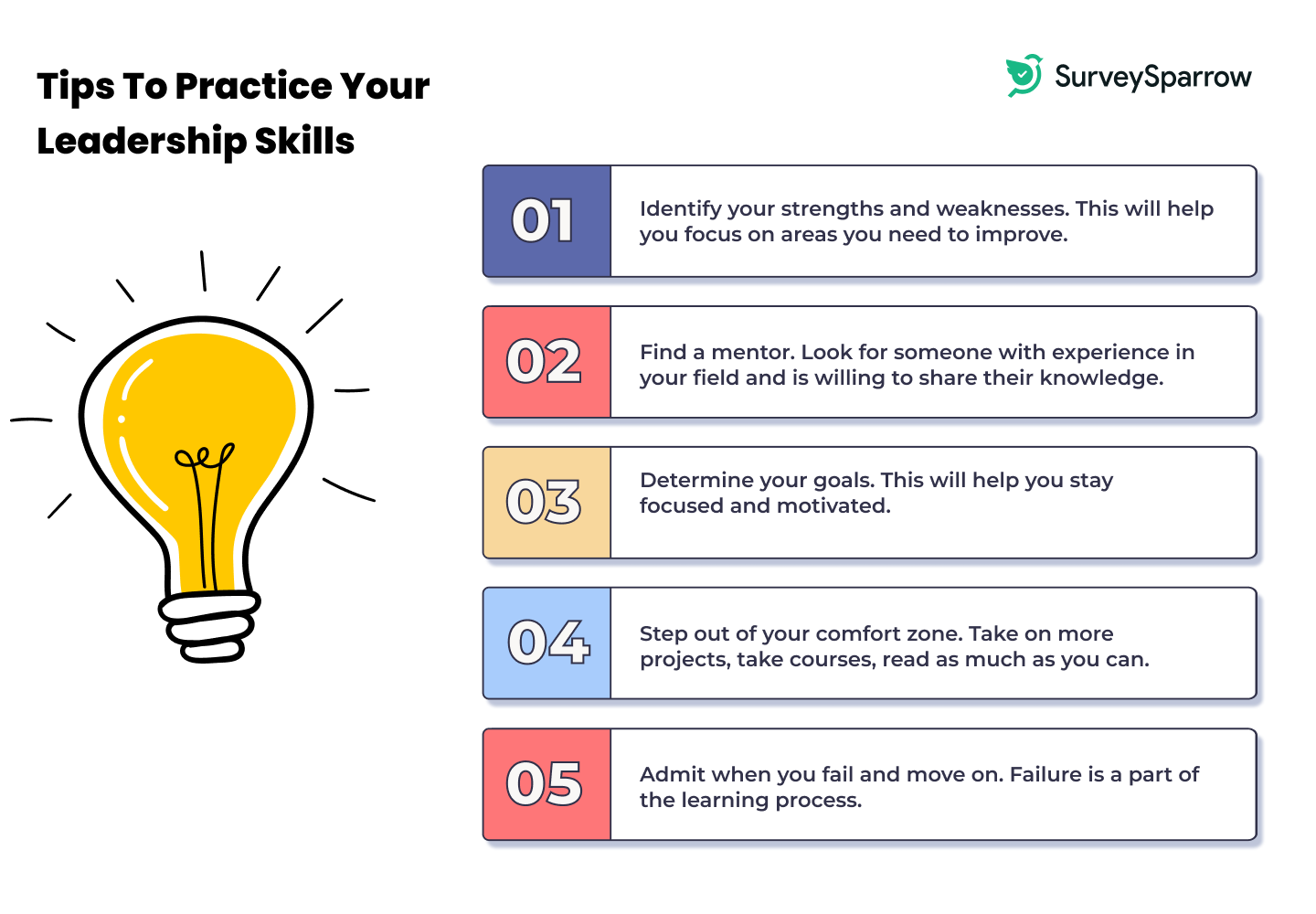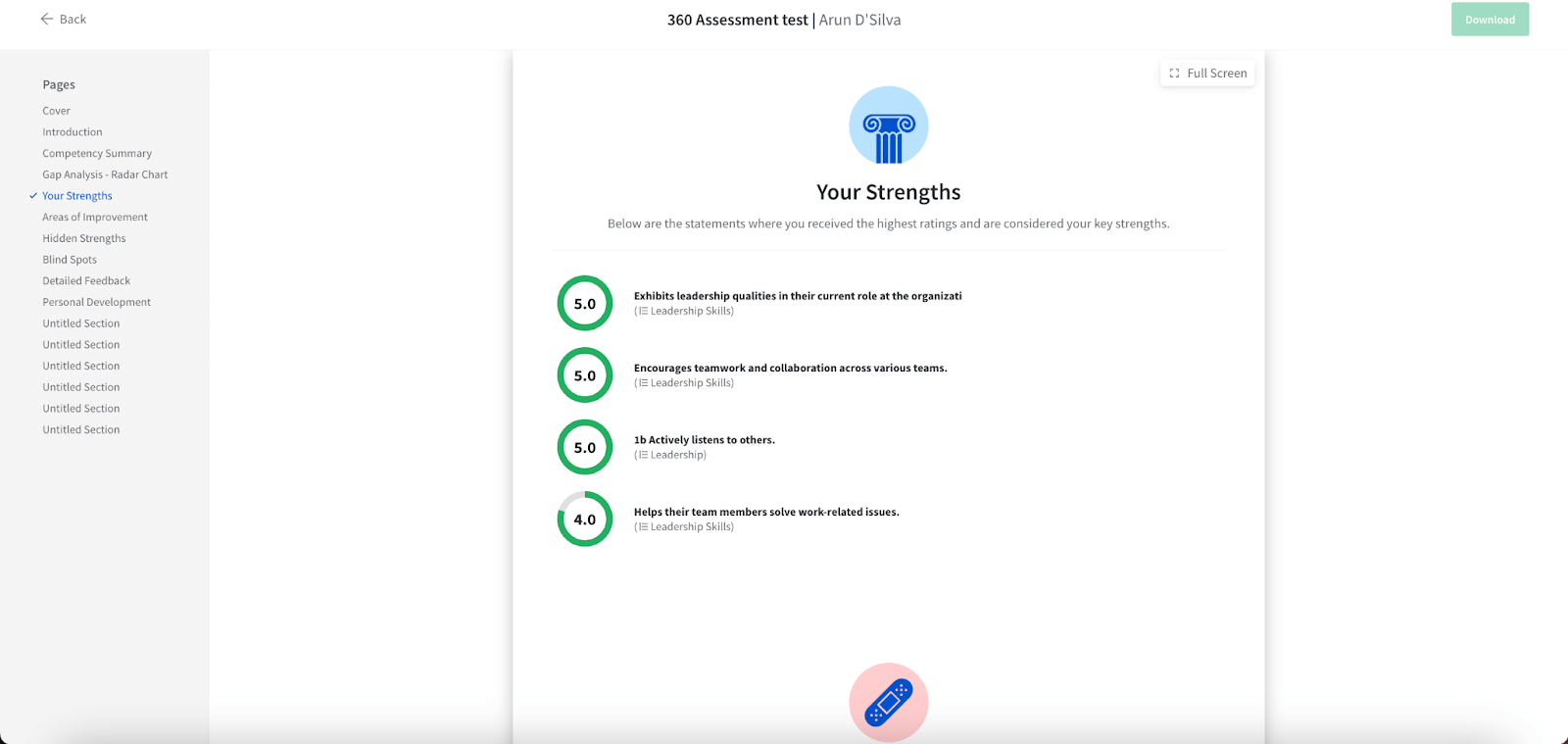Employee Experience
Mastering Leadership Competencies: Key Skills for Effective Leaders
Article written by Parvathi Vijayamohan
Content marketer at SurveySparrow.
9 min read
13 December 2024

Who do you think of as a good leader? If you’re an entrepreneur, it could be Jeff Bezos. If you’re a sports fan, it might be MS Dhoni or Roy Keane. Or it could even be a manager who helped you during a tough time in your career.
Companies also struggle with this question, which is why we use leadership competencies to define a good leader. In this article, we are going to:
- Pin down the best definition of leadership.
- Define the meaning & purpose of leadership competencies
- Talk about 13 leadership competencies divided into 4 areas.
- Share insights from three experts about future leader competencies.
- Explore how 360 assessments can help develop leadership skills.
What Is The Best Definition of Leadership?
Leadership is a complex concept that has been studied and debated for a long time. There are many interpretations of what leadership is, and no agreed-upon definition.
However, good leadership has a few common themes. Let’s take a look at three definitions from the web:
Definition #1
According to McKinsey:
- Leadership is a set of behaviors used to guide individuals to: work together towards a common goal, execute important plans, and consistently improve an organization.
- It’s about guiding and influencing the results achieved by a group of people, enabling them to collaborate and achieve things that would be difficult or impossible for them to accomplish alone.
- Leadership is something you do, not something you are. Some people in formal leadership roles are poor leaders, while many people who show leadership have no formal authority. It’s their actions, not their words, that inspire trust and enthusiasm.
Definition #2
TechTarget defines leadership as:
- The ability of an individual or a group to influence and guide others within an organization, society, or team.
- Leadership skills can be developed and enhanced with practice.
- Leaders play important roles in various domains such as business, politics, religion, and social or community organizations.
- Leaders are known for making wise decisions, even when they are tough.
- They communicate a clear vision, set realistic goals, and provide the necessary support and resources for their followers to accomplish those goals.
Definition #3
Tony Robbins views leadership as:
- The ability to influence, inspire, and help others become their best selves.
- Along the way, they build their skills and achieve their goals.
- Leadership is about creating and sustaining positive, lasting change in your life and the lives of the people around you.
- It is a powerful skill that can be developed over time.
Notice a pattern here? In short, leadership is:
- A set of behaviors that can be developed over time.
- Influences the results achieved by a group of people
- Enables the group to work together to achieve something that they can’t while working alone.
- Creates and sustains positive, lasting change in the lives of others.
The definition of a leader can also vary depending on the role, industry, and organizational culture. The leadership skills needed in the military, for example, may vary from those required to run a non-profit.
That takes us to the next question.
What are Leadership Competencies?
Leadership competencies are the specific skills, knowledge, and attributes that enable individuals to effectively lead and manage others. These competencies typically include qualities such as communication, strategic thinking, problem-solving, EQ, and the ability to motivate others.
Measuring leadership competencies is crucial because:
- It helps organizations identify and develop strong leaders.
- By assessing these competencies, organizations can make better decisions when selecting leaders, planning for future leadership roles, and designing leadership development programs.
- It’s like taking a closer look at what makes a leader effective, then aligning those qualities with the organization’s goals. This will maximize chances of success.
“Companies fail to choose the candidate with the right talent for the job 82% of the time.”
- Randall J. Beck, Why Great Managers Are So Rare
Leadership assessments are valuable tools for measuring and comparing these skills. HR uses these tools to create leadership competency models that identify capable leaders.
Ready to unlock your team’s leadership potential? Discover actionable insights with SurveySparrow’s powerful 360 leadership assessments. Sign up below.
A personalized walkthrough by our experts. No strings attached!
Universal Leadership Competencies: 4 Essential Areas for All Leaders
Let’s look at the core leadership competencies that can be applied to every leader – regardless of their team or department.
- Communication Competencies
- Team Empowerment Competencies
- Coaching & Mentoring Competencies
- Intrapersonal Leadership Competencies
Area A: Communication Competencies
#1. Persuasion & Negotiation:
- Ability to present individual and organizational perspectives to groups clearly and persuasively.
- Skillful at building agreement and co-operation to get information or achieve a mutual goal.
#2. Written Communication: Ability to write thoughts and ideas clearly and concisely for the intended audience.
#3. Oral Communication:
- Ability to convey thoughts and ideas verbally, clearly, and concisely.
- Skilled at listening to understand, not respond.
- Clarifies information and doubts as needed.
Area B: Team Empowerment Competencies
#4. Participative Management:
- Involves team members in organizational planning, decision making, and problem-solving processes.
- Builds valuable working relationships with coworkers, other teams, and external parties.
#5. Employee Recognition: Rewards and recognizes performance in a timely and appropriate manner.
#6. Team Management:
- Provides team members with regular and timely feedback on their performance.
- Offers support and guidance when individuals are confronted with problems.
Area C: Coaching and Mentoring Competencies
#7. Respectful of Differences:
- Ability to attract and retain diverse talent.
- Valuing diverse perspectives from people of different backgrounds and cultures.
#8. Development of Others: Ability to coach, train and develop talent.
#9. Team-Building: Ability to create and develop engaged, cohesive, high-performance teams.
Area D: Intrapersonal Leadership Competencies
10. Continual learning:
- Initiates self-development.
- Willingness to question established ways of doing things.
- Ability to effectively manage one’s time, energy, and skills for continuous personal growth and maximum performance.
11. Resilience:
- Ability to stay composed under pressure and stress.
- Ability to bounce back from setbacks.
12. Flexibility:
- Effectively cope with ambiguity and change.
- Ability to rapidly adapt to new situations, information, and hurdles.
13. Conflict management:
- Confronts complex issues and takes constructive action.
- Ability to deal decisively and fairly with problem coworkers.
Future-Ready Leadership Competencies: 9 Skills for Tomorrow’s Leaders
Welcome to a VUCA (Volatile, Uncertain, Complex, Ambiguous) world
“The rate of change in the business world today is greater than our ability to respond,” states Tanmay Vora, performance improvement specialist, and author. To adapt, leaders will also have to radically change their mindset.
This will require leader competencies like:
- An abundance mindset: Spot the growth possibilities in challenges and unique problems and meld different disciplines instead of simply doing what’s required.
- A beginner’s mind: Constant curiosity and the willingness to learn and unlearn as necessary.
- Design for the future: Develop a purpose-driven infrastructure, methods, systems, and processes that will continue to thrive even in their absence.

Integrity matters.
“Human resources teams and learning and development professionals tend to focus on what is commonly recognized as core leadership competencies,” says Ann Holland, organizational development consultant. “I believe there are important competencies not included on that list that future leaders should also consider and develop.”
Some of those leadership skills include:
- Integrity: This competency can be summed up in one sentence – “Do the right thing – even when no one’s looking.”
- Open-mindedness: To a degree, we are all frogs in a well. But a good leader always tries to figure out how big the well is and stays receptive to other viewpoints.
- Discerning thinking: In this age of information and misinformation, a leader will need the ability to discern between facts, perceptions, assumptions and interpretations.
Learning from the future
“Historically, present leaders have been expected to help mentor and develop future leaders,” states business thinker Marshall Goldsmith. “While this will still be true in the future, there may be a major addition to the process – future leaders may be recruited to help mentor and develop present leaders.”
His research uncovered a few leadership competencies where present leaders are likely to fall behind, and these include:
- Building partnerships: In a world where outsourcing, restructuring, and downsizing have become the norm, the ability to manage complex networks of people and resources will be a crucial trait for a future leader.
- Sharing leadership: Within such a fluid network, a leader should be comfortable sharing leadership with partners who are experts in their domain.
- Tech savviness: According to Marshall, this does not mean being a computer programmer or scientist. Instead, being tech-savvy includes:
- Understanding how new tech can help their company
- Making and managing investments in tech
- Recruiting and managing technically competent people.
Measuring Leadership Competencies: The Power of 360 Assessments for Benchmarking Leadership Performance
- According to Dr. Joel M. Rothaizer, leadership is not just about our intentions, but about the actual impact we have on others. 360 leadership reviews help assess how our leadership skills affect different groups such as peers, managers, and direct reports, enabling us to further refine those competencies.
- 360 leadership assessments gather diverse perspectives from colleagues, including peers and higher-level professionals. Online and interview-based assessments provide a comprehensive overview of a leader’s management practices.
- One significant advantage of 360 reviews is uncovering a leader’s hidden strengths and blind spots. This valuable information can be used to create personalized development plans for each leader.
- Teams and cultures often foster different leadership styles, consciously or unconsciously. 360 assessments offer insights into the dominant leadership styles within your work culture.
Wrapping Up
In this article, we’ve explored the common themes in leadership, the purpose of leadership competencies, the essential types of competencies, and the role of 360 assessments in measuring them.
By continuously measuring and honing these skills, you can empower yourself and your employees to inspire and guide others, drive success and making a positive impact. Good luck!
Start 14 Days free trial

Parvathi Vijayamohan
Parvathi is a sociologist turned marketer. After 6 years as a copywriter, she pivoted to B2B, diving into growth marketing for SaaS. Now she uses content and conversion optimization to fuel growth - focusing on CX, reputation management and feedback methodology for businesses.
Related Articles

Employee Experience
What Is Employee Engagement? The 6th Answer Will Surprise You!
12 MINUTES
26 November 2018

Customer Experience
The Beginner's Guide to Market Research Surveys
13 MINUTES
29 May 2018

Employee Experience
Powerful Examples of Peer-to-Peer 360 Feedback for Enhanced Growth and Development
5 MINUTES
30 May 2023

Best Of
6 Important KPIs That Training Managers Should Track in 2025
15 MINUTES
20 August 2020



